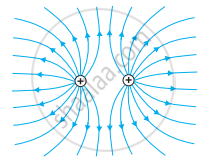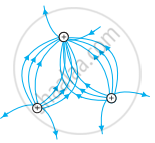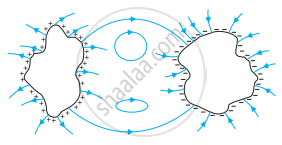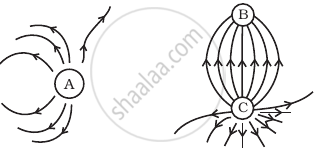Advertisements
Advertisements
Question
The magnitude of the electric field due to a point charge object at a distance of 4.0 m is 9 N/C. From the same charged object the electric field of magnitude, 16 N/C will be at a distance of ______.
Options
1 m
2 m
3 m
6 m
Solution
The magnitude of the electric field due to a point charge object at a distance of 4.0 m is 9 N/C. From the same charged object the electric field of magnitude, 16 N/C will be at a distance of 3 m.
Explanation:
We know that,
E = `(kq)/r^2`
Where E is the magnitude of the electric field, k is constant, q is a charge of magnitude and r is the distance away from the point charge.
Given: E1 = 9 N/C, r1 = 4 and k = `9 xx 10^9` Nm2/C2, E2 = 16 N/C and q is same for both objects.
To find: r2
`E_1 = (kq)/r_1^2`
`9 = ((9 xx 10^9 xx q))/4^2`
`q = ((9 xx 16))/((9 xx 10^9))`
q = 16 × 10-9
`E_2 = (kq)/r_2^2`
`16 = ((9 xx 10^9 xx 16 xx 10^-9))/r_2^2`
`r_2^2 = 9`
`r_2 = 3` m
RELATED QUESTIONS
- An electrostatic field line is a continuous curve. That is, a field line cannot have sudden breaks. Why not?
- Explain why two field lines never cross each other at any point?
Which among the curves shown in the fig. cannot possibly represent electrostatic field lines?
(a)

(b)

(c)

(d)

(e)

A thin, metallic spherical shell contains a charge Q on it. A point charge q is placed at the centre of the shell and another charge q1 is placed outside it as shown in the following figure. All the three charges are positive. The force on the central charge due to the shell is ______.
Answer the following question.
Draw the pattern of electric field lines when a point charge +q is kept near an uncharged conducting plate.
Explain why two field lines never cross each other at any point?
A point positive charge is brought near an isolated conducting sphere (figure). The electric field is best given by ______.
Which of the following figures represent the electric field lines due to a single negative charge?
An electron enters an electric field with its velocity in the direction of the electric lines of force. Then ______
Figure shows the electric field lines around three point charges A, B and C.

- Which charges are positive?
- Which charge has the largest magnitude? Why?
- In which region or regions of the picture could the electric field be zero? Justify your answer.
(i) near A, (ii) near B, (iii) near C, (iv) nowhere.
